Tulip Experts Reveal The Top 7 Planting Mistakes Gardeners Make – And How To Fix Them
We reached out to experts to discover where most gardeners go wrong when planting tulips – read on to discover the common mistakes to avoid.

Amy Draiss
There is no other spring flower filled with as much color and optimism as the tulip. However, in order to create a dazzling seasonal display in the garden, you must give some careful consideration to planting your bulbs.
Growing tulips successfully starts at the buying stage. Ensure you purchase from a reputable garden center, and choose types of tulip flowers that will be suitable for your location and level of expertise.
It's particularly frustrating when bulb plants are not flowering, especially when you have invested so much time and effort.
We reached out to experts to discover where most gardeners go wrong when planting tulips – read on to discover the common mistakes to avoid.
1. Not planting enough bulbs
‘When we think of tulips, what often comes to mind is pictures from the Netherlands showcasing masses of blooms,’ says Peggy Anne Montgomery, horticulturist representing Flowerbulbs.com.
However, many gardeners simply don’t plant enough bulbs to make this kind of impact.
‘Tulips and other flowering bulbs look best planted close together in large numbers. If you want that Instagram-worthy display, plant as many as you can,’ adds Peggy Anne.
Sign up for the Gardening Know How newsletter today and receive a free copy of our e-book "How to Grow Delicious Tomatoes".
The good news is that tulips can be planted quite close together. ‘Large bulbs can be planted 4-6” apart, and smaller ones can be planted 2-3” apart. When tulips are planted in containers, they can be planted right next to each other.
‘Most bulb retailers sell mixtures of tulips. These have been selected to showcase outstanding color combinations, making your display look very professional. You can also use succession planting to keep the flower show going.’

2. Lack of preparation
Good preparation is essential for a showy display of tulips, so don’t skip this step. ‘To ensure your tulips thrive, put some effort into creating the ideal planting site,’ says gardening expert Leigh Clapp.
‘Good drainage is important and ideally soil on a loamy, sandy side, in sun or light shade areas. In heavy soil, mix grit into the base of the planting hole.’
You should also incorporate organic matter to improve the soil structure and provide nutrients for the bulbs.
3. Planting tulips at the wrong depth
Different bulbs need to be planted at different depths. You can check the planting information provided with your tulips, but generally speaking it’s three times the height of the bulb.
‘If you’re planting your bulbs in pots, lasagna planting is a popular method to get the most from them. It involves bulbs being planted in layers, so it is key to choose varieties with different planting depths,’ says Dan Dunbar, bulb expert for Hillier.
When making small holes, you can use a dibber, but a bulb planter is ideal for making holes for bigger bulbs.

4. Not getting the longest bloom time
Get this step wrong and your tulip display will be over before it’s barely started.
‘Tulips bloom for two to three weeks, but you can extend the flower show for many weeks by planting several varieties that flower at different times,’ says Peggy Anne.
‘They are listed in catalogs as early spring flowering, mid-spring flowering, and late spring flowering – or similar. Planting a mixture of these extends the bloom time by many weeks and increases your pleasure exponentially.’
5. Planting tulips at the wrong time
Ideally tulips should be planted in the fall. However, depending on where you live – check your USDA zone – the exact timing can vary.
In general, it's best not to plant your bulbs too early, as they are more likely to develop one of the common diseases of tulips, such as tulip fire.
'Plant your bulbs later in the season, say in November, to avoid the squirrel and chipmunk hoarding season,' says Gail Pabst from the National Garden Bureau.
'I always advise to plant later, but be sure to order early for the best bulb selection!'
If you leave it too late to plant your tulips and the ground has frozen solid, then it may not be too late. You can store them in the refrigerator over winter, and plant them out in early spring.

6. Not feeding the bulbs
To encourage growth and regeneration, Dan Dunbar recommends adding a bulb starter containing mycorrhizal fungi during the planting process. Properly fertilizing tulips will also help them to come back the following year.
‘Sprinkle a small amount under the bulbs when planting to encourage them to develop a secondary root system. This helps the plants to take up more feed,' he says.
'Applying fish, blood and bone as the bulbs start to die down also aids regeneration and will be a benefit to all bulbs.'
Also take care when watering tulip bulbs to ensure you don't overdo it.
7. Expecting tulips to come back every year
‘While technically considered perennial, some tulips have been bred to produce an exceptionally large or full bloom the first spring after planting and diminish in numbers years after,’ explains Peggy Anne.
‘These modern hybrids are terrific for seasonal display and cutting gardens when the bulbs will be removed to make way for a colorful annual show or annual cut flowers. Without knowing that, gardeners can be disappointed when they do not return. I like to think of these as annuals, and the price point is certainly the same.’
‘Bulbs are usually treated as annuals and dug out for storing when they finish blooming,’ adds Gail Pabst.
‘Under ideal growing conditions (sharply drained soil, cold winters, cool springs, hot, dry summers) some tulips will return to bloom again another year.'
There are some great tips for getting tulips to rebloom, but key to this is choosing the right varieties.
‘The best candidates are Darwin hybrids and Species tulips,' continues Gail. 'To encourage re-blooming, cut off the spent flowers as soon as they fade and allow the foliage to continue growing until it is yellow and dry.’

Melanie is an experienced gardener and has worked in homes and gardens media for over 20 years. She previously served as Editor on Period Living magazine, and worked for Homes & Gardens, Gardening Etc, Real Homes, and Homebuilding & Renovating. Melanie has spent the last few years transforming her own garden, which is constantly evolving as a work in progress. She is also a passionate organic home grower, having experimented with almost every type of vegetable at some point. In her home, Melanie tends to an extensive houseplant collection and is particularly fond of orchids.
- Amy DraissDigital Community Manager